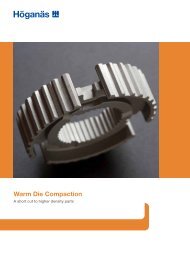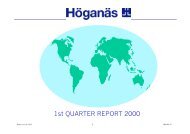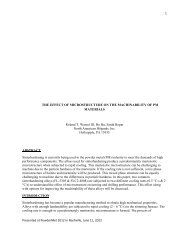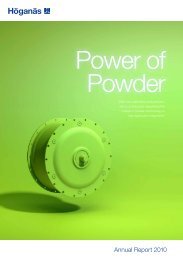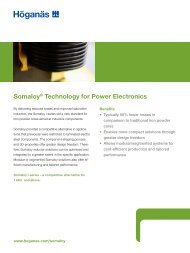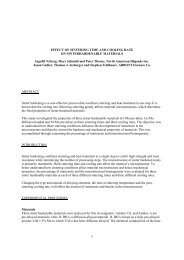Machining of High Strength PM Steels - Höganäs AB
Machining of High Strength PM Steels - Höganäs AB
Machining of High Strength PM Steels - Höganäs AB
You also want an ePaper? Increase the reach of your titles
YUMPU automatically turns print PDFs into web optimized ePapers that Google loves.
<strong>Machining</strong> <strong>of</strong> <strong>High</strong> <strong>Strength</strong> <strong>PM</strong> <strong>Steels</strong><br />
Ol<strong>of</strong> Andersson*, Hans Thordenberg**, Sigurd Berg*<br />
*<strong>Höganäs</strong> <strong>AB</strong>, S-26383 <strong>Höganäs</strong>, Sweden<br />
**<strong>AB</strong> Sandvik Coromant, S-811 81, Sandviken, Sweden<br />
Abstract<br />
P/M is a net or near net shape process. <strong>Machining</strong> operations are used for many applications<br />
in order to reach final tolerances or shapes not possible to achieve in the compaction step. The<br />
use <strong>of</strong> high strength <strong>PM</strong> steels have increased in recent time. Guidelines for insert choice and<br />
effect from additives are needed to improve the performance in the machining operation for<br />
these application areas.<br />
This paper describes the machinability <strong>of</strong> a fully bainitic high strength <strong>PM</strong> material. An<br />
optimum is found regarding settings <strong>of</strong> the insert for which properties like insert life time and<br />
surface roughness are improved. Machinability additives performance and their influence on<br />
physical and mechanical properties are shown for machining <strong>of</strong> such <strong>PM</strong> material.<br />
Introduction<br />
<strong>PM</strong> is a well-known method for producing large series <strong>of</strong> complex parts to very close<br />
tolerances. However, today many <strong>PM</strong> components require some type <strong>of</strong> machining operation<br />
to reach final shape, e.g. shapes impossible to create with the compaction exclusively or due<br />
to demands for even higher tolerances.<br />
<strong>PM</strong> materials are <strong>of</strong>ten considered to be difficult to machine, especially compared to<br />
conventional standard steels. However, by choosing a proper combination <strong>of</strong> tool material and<br />
insert geometry together with optimised cutting data, and if also necessary, additives, it is in<br />
many cases possible to reach a productivity level as high as <strong>of</strong> standard steels [1][2].<br />
In this study a turning operation has been performed on a relatively new <strong>PM</strong> material, the<br />
chromium and molybdenum prealloyed AstaloyCrM [3], in a fully bainitic condition with<br />
high strength properties. In this paper the influence <strong>of</strong> tool grades, insert geometries, additives<br />
and cutting data, when machining this type <strong>of</strong> <strong>PM</strong> material will be presented.<br />
Experimental<br />
Three powder mixes [Table 1] were manufactured in order to compact turning test specimens,<br />
with geometry Ø64/Ø35 x 45 mm, and test bars to evaluate mechanical properties. All<br />
specimens were compacted at 700 MPa to a green density <strong>of</strong> 7.0 g/cm³.<br />
Table 1. Powder mixes based on AstaloyCrM<br />
<strong>PM</strong> material Composition<br />
Material 1 Astaloy CrM + 0.37% Graphite + 0.8% Kenolube<br />
Material 2 Astaloy CrM + 0.37% Graphite + 0.8% Kenolube + 0.5% MnS<br />
Material 3 Astaloy CrM + 0.37% Graphite + 0.8% Kenolube + 0.3% MnX<br />
MnX is a patented product <strong>of</strong> <strong>Höganäs</strong> <strong>AB</strong> that has been found effective as a pre-mix additive<br />
in the machining <strong>of</strong> <strong>PM</strong> steels.<br />
Presented at <strong>PM</strong>2004, in Vienna, Austria, October 2004<br />
1
Green specimens were sintered in a laboratory belt furnace at 1120ºC for 30 minutes in an<br />
atmosphere <strong>of</strong> 90% nitrogen/10% hydrogen, and with additional 0.2% methane to maintain a<br />
good carbon control. The cooling rate in the end <strong>of</strong> the sintering cycle was 0.8ºC/s. For all<br />
three material compositions a fully bainitic structure [Fig. 1] was obtained.<br />
Figure 1: Sintered AstaloyCrM + 0.37%C. Etched with nital/picral.<br />
The influence by the additives can be observed in terms <strong>of</strong> minor reductions in strength<br />
[Table 2]. However, the micro hardness <strong>of</strong> the bainitic matrix is independent whether the mix<br />
consists <strong>of</strong> additives or not.<br />
Table 2: Mechanical properties <strong>of</strong> sintered test specimens<br />
<strong>PM</strong> material SD HV10 MHV0.05 DC TS YS MnS IE<br />
Material 1 7.0 236 376 -0.20 833 625 0.6 14<br />
Material 2 7.0 228 370 -0.21 787 571 0.9 13<br />
Material 3 7.0 234 372 -0.17 780 572 0.8 15<br />
SD:<br />
HV10:<br />
Sintered density [g/cm³]<br />
Hardness measured on polished cross section <strong>of</strong> turning test specimen [MPa]<br />
MHV0.05: Micro hardness measured on polished cross section <strong>of</strong> turning test specimen [MPa]<br />
DC:<br />
TS:<br />
YS:<br />
A:<br />
IE:<br />
Dimensional change from as-green to as-sintered [%]<br />
Tensile strength [MPa]<br />
Yield strength [MPa]<br />
Elongation [%]<br />
Impact energy [J]<br />
A CNC lathe (Mazak) was used to face turn the cylinder specimens. The surface to a depth <strong>of</strong><br />
0.5 mm was removed in order to secure the performance <strong>of</strong> the different inserts and<br />
geometries. Influence <strong>of</strong> surface variation, like carburisation, decarburisation or oxidation is<br />
therefore eliminated in comparsion test.<br />
Turning tests <strong>of</strong> AstaloyCrM without additive (Material 1) – Preparatory tests<br />
One <strong>of</strong> the first attempts to machine AstaloyCrM was carried out with a CVD coated<br />
cemented carbide insert, CNMG120408-WF [4]. With start-up cutting data (Vc = 150 m/min,<br />
f = 0.1 mm/r, ap = 0.5 mm) and dry machining the insert was inspected every tenth pass, up to<br />
50 passes. The dominating wear mechanism was found to be adhesion in terms <strong>of</strong> severe built<br />
up edge (BUE) and a heavily smearing effect, i.e. pressure-welded specimen material, on<br />
clearance flank [Fig. 2]<br />
Presented at <strong>PM</strong>2004, in Vienna, Austria, October 2004<br />
2
Figure 2: BUE and smearing on insert CNMG120408-WF<br />
In an attempt to reduce BUE and smearing effects, cutting speed was increased in order to<br />
change cutting edge temperature and in this way s<strong>of</strong>ten the built up layer and replace it with a<br />
flow zone. The BUE can be reduced with an increased cutting speed however, pressuredwelded<br />
material is still heavily smeared on the clearance flank and close to secondary cutting<br />
edge [Fig. 3] which would in the end jeopardize the machined surface quality.<br />
Vc = 200 m/min Vc = 250 m/min Vc = 300 m/min<br />
Figure 3: BUE and smearing on insert CNMG120408-WF. Turning with increased cutting speeds.<br />
In a next step to reduce BUE and smeared material on tool insert, cutting fluid (emulsion <strong>of</strong><br />
water and 5% Castrol Syntilo XPS) was applied. The use <strong>of</strong> cutting fluid was found to be <strong>of</strong><br />
significant importance [Fig. 4] since BUE and a large amount <strong>of</strong> the smearing could be<br />
eliminated.<br />
Vc = 200 m/min Vc = 250 m/min Vc = 300 m/min<br />
Figure 4: CNMG120408-WF. Turning with increased cutting speeds and applied cutting fluid.<br />
Turning tests <strong>of</strong> AstaloyCrM without additive (Material 1) – Optimizations<br />
Two measurements have proven to minimize or eliminate the smearing tendencies; cutting<br />
speed in some remarks but especially the addition <strong>of</strong> cutting fluid with significant result. To<br />
make further optimizations, with regards to an increased tool life, different insert grades [4],<br />
i.e. substrates and coatings, applied on insert CCMT09T308 [4], a positive design compared<br />
with the negative CNMG, were tested. All tests were performed until flank wear on tool insert<br />
had reached the standardized length <strong>of</strong> 0.3 mm. The two most successful grades [Fig. 5] were<br />
grade CT5015 (uncoated WC-Co cermet) and a new developed grade GC3215 (solid carbide,<br />
coated with TiCN, Al2O3 and TiN).<br />
Presented at <strong>PM</strong>2004, in Vienna, Austria, October 2004<br />
3
No <strong>of</strong> passes to Vb = 0.3 mm<br />
Figure 5: Tool life with different insert grades and same tool geometry.<br />
With the cermet grade CT5015 the influence <strong>of</strong> geometry was tested by choosing different<br />
cutting edge designs (-WF, -PF and -<strong>PM</strong>) applied on CCMT09T308 [4]. In this test an insert<br />
with a more improved tolerance by grinding, the CCGT09T308-UM [4], also was tested. The<br />
result [Fig. 6] <strong>of</strong> this test indicates that a well-defined edge radius and sharpness affects the<br />
tool life when machining the AstaloyCrM without additives, i.e. the G-tolerance geometry<br />
CCGT09T308-UM exhibits the best performance.<br />
No <strong>of</strong> passes to Vb = 0.3 mm<br />
150<br />
125<br />
100<br />
75<br />
50<br />
25<br />
0<br />
250<br />
200<br />
150<br />
100<br />
50<br />
0<br />
CCMT09T308 (-KM/<strong>PM</strong>/MM)<br />
Vc = 300 m/min<br />
f = 0.10 mm/r<br />
ap = 0.5 mm<br />
With cutting fluid<br />
GC1025 GC1005 GC4025 GC2015 GC2025 GC4015 GC3215 CT5015<br />
CCMT09T308 (-WF, -PF, <strong>PM</strong>)<br />
CCGT09T308-UM<br />
Vc = 250 m/min, f = 0.1 mm/r<br />
ap = 0.5 mm<br />
With cutting fluid<br />
- WF - PF - <strong>PM</strong> - UM<br />
Figure 6: Tool life with same insert grade and different tool geometries.<br />
Turning tests <strong>of</strong> AstaloyCrM with addition <strong>of</strong> MnS or MnX (Material 2 & 3)<br />
The influence <strong>of</strong> additives in AstaloyCrM was dramatically shown in the first test with tool<br />
insert CNMG120408-WF [Fig. 7]. With the same type <strong>of</strong> tool insert and with the same cutting<br />
data that was used when AstaloyCrM without additive was machined (Vc = 150 m/min, f =<br />
0.1 mm/r, ap = 0.5 mm) the presence <strong>of</strong> BUE and smeared material on clearance flank was<br />
non-existent, even when the machining took place without cutting fluid, i.e. dry.<br />
Without additive With + 0.3% MnX With + 0.5% MnS<br />
Figure 7: Edge integrity <strong>of</strong> CNMG120408-WF.<br />
With the intention to optimize machinability the so far successful grades, CG3215 and<br />
CT5015 were applied on the insert tool CCMT09T308-WF. All tests were done with cutting<br />
fluid. The best machining performance was found for the coated solid carbide GC3215 and<br />
Presented at <strong>PM</strong>2004, in Vienna, Austria, October 2004<br />
4
not, as previous was stated in the case AstaloyCrM without additives, the uncoated cermet<br />
CT5015 [Fig. 8].<br />
No <strong>of</strong> passes to Vb = 0.3 mm<br />
800<br />
700<br />
600<br />
500<br />
400<br />
300<br />
200<br />
100<br />
0<br />
+ MnS<br />
Figure 8: Tool life when machining AstaloyCrM + additive with<br />
different insert grades and same tool geometry.<br />
The additives are beneficial to tool life, especially AstaloyCrM + 0.5% MnS, even at feed<br />
rate 0.3 mm/r. The presence <strong>of</strong> MnX eliminates pressured-welded material but a higher wear<br />
rate, in terms <strong>of</strong> flank and crater wear, can be observed compared to the wear rate with the<br />
addition <strong>of</strong> MnS. Yet, addition <strong>of</strong> MnX will improve the machinability.<br />
Tool life for AstaloyCrM with or without addition <strong>of</strong> MnS (Material 1 & 2)<br />
The Vt-graph [Fig. 9] shows a divided behaviour when AstaloyCrM without additive is<br />
machined, expressed with two alpha-values (curve slopes). At lower cutting speeds, i.e. less<br />
than 250 m/min, the wear process is gradually more and more influenced by smearing and<br />
BUE formation. With increased feed rate (0.3 mm/r) tool life will be heavily reduced.<br />
However, with the addition <strong>of</strong> MnS higher cutting speed (>250 m/min) together with higher<br />
feed rates (up to 0.3 mm/r) can be used with maintained tool life.<br />
Tool life to Vb = 0.3 mm [min]<br />
100<br />
30<br />
20<br />
10<br />
Increased BUE and<br />
smearing<br />
Figure 9: Vt-graph<br />
Gains by optimization <strong>of</strong> inserts and addition <strong>of</strong> MnX or MnS<br />
A comparison <strong>of</strong> gains in tool life (number <strong>of</strong> passes) and productivity (feed rate) shows the<br />
influence <strong>of</strong> additive [Fig. 10]. The gains are relatively to the turning tests <strong>of</strong> AstaloyCrM<br />
without additive, that was turned with insert CCGT09T308-UM (CT5015) and feed rate<br />
0.1 mm/r. The MnS and MnX variants were turned with insert CCMT09T308-WF (GC3215)<br />
and feed rate 0.3 mm/r. With addition <strong>of</strong> MnS the gain in tool life and productivity is<br />
remarkable, three times as high. Even the addition <strong>of</strong> MnX is beneficial with respect to<br />
productivity. Insert geometry and feed rate will by natural causes influence the surface<br />
roughness <strong>of</strong> the machined part. With the wiper geometry CCMT09T308-WF a lasting<br />
5<br />
Presented at <strong>PM</strong>2004, in Vienna, Austria, October 2004<br />
+ MnS<br />
CCMT09T308-WF<br />
Vc = 250 m/min<br />
f = 0.3 mm/r<br />
ap = 0.5 mm<br />
With cutting fluid<br />
+ MnX<br />
CT5015 GC3215 GC3215<br />
f = 0.2mm/r<br />
f = 0.3mm/r<br />
Without additive, insert CCGT09T308-UM (CT5015), f = 0.1 mm/r<br />
With 0.5% MnS, insert CCMT09T308-WF (GC3215)<br />
Without additive, f = 0.3 mm/r<br />
1<br />
100 200 250 300 400<br />
1000<br />
Cutting Speed [m/min]
surface quality will be obtained on parts made <strong>of</strong> AstaloyCrM + 0.5% MnS, even with feed<br />
0.3 mm/r [Fig. 11]<br />
Gain (relatively)<br />
4<br />
3<br />
2<br />
1<br />
0<br />
Gain "Tool life" Gain "Productivity"<br />
Without additive With MnX With MnS<br />
Figure 10: Comparison <strong>of</strong> tool life and productivity.<br />
Vc = 250 m/min, ap = 0.5 mm, with cutting fluid.<br />
Presented at <strong>PM</strong>2004, in Vienna, Austria, October 2004<br />
Surface roughness Ra [µm]<br />
3,5<br />
3,0<br />
2,5<br />
2,0<br />
1,5<br />
1,0<br />
0,5<br />
0,0<br />
GC3215-KM<br />
GC3215-WF<br />
CCMT09T308 (-WF, KM)<br />
Vc = 250 m/min,<br />
f = 0.3 mm/r<br />
ap = 0.5 mm<br />
With cutting fluid<br />
0 5 10 15 20 25<br />
Tool contact time [min]<br />
Figure 11: Surface roughness vs. cutting time.<br />
Astaloy CrM + 0.5% MnS<br />
6
Discussion<br />
The use <strong>of</strong> cutting fluid has in previous investigations not been recommended in turning<br />
operations with <strong>PM</strong> steel material because <strong>of</strong> the observed wear effects [5]. However, with<br />
respect to the bainitic AstaloyCrM without additive, when the choice is between a<br />
predictable and controlled wear (with cutting fluid) or an unpredictable and uncontrolled (dry)<br />
the choice whether cutting fluid should be used or not appears obvious.<br />
For comparative reasons all tool life tests have been performed with cutting fluid. Yet, the<br />
turning operation <strong>of</strong> the additive variants would most likely perform as well, or even better, in<br />
dry condition.<br />
Conclusions<br />
A. Turning <strong>of</strong> bainitic Astloy CrM without additive:<br />
• The dominating wear mechanism is adhesion in terms <strong>of</strong> BUE and pressure-welded<br />
material on clearance flank.<br />
• The adhesion wear is reduced by using as sharp cutting edges as possible, increasing the<br />
cutting speed and the use <strong>of</strong> cutting fluid.<br />
• Best machining performance is achieved by using cermet grade CT5015.<br />
• It is not possible to use high feed rates and productive wiper inserts. A higher load will<br />
increase the adhesion wear.<br />
B. Turning <strong>of</strong> bainitic Astaloy CrM with additive:<br />
• The machining exhibits a completely different behaviour compared to the non additive<br />
variant. BUE and smearing tendencies are in principle eliminated.<br />
• One <strong>of</strong> the general machining recommendations for <strong>PM</strong>-material is to use as sharp cutting<br />
edges as possible. This recommendation is not so important when MnS and MnX are<br />
added to the tested <strong>PM</strong> material.<br />
• Best machining performance is achieved with hard metal grade GC3215.<br />
• Three times higher productivity and tool life is achieved by MnS compared with variant<br />
without additive.<br />
• Three times higher productivity is achieved by additive MnX compared with variant<br />
without additive.<br />
• The best overall performance is obtained with AstaloyCrM + 0.5% MnS. Excellent<br />
results have been achieved, both in tool life and surface roughness, with feed rates up to<br />
0.3 mm/r together with the high productive wiper insert, CCMT09T308-WF.<br />
References:<br />
1. Berg, S. ”Cutting data Recommendations for Turning <strong>of</strong> Various P/M Materials Using<br />
Different Tool Grade and Geometry Selections”. Paper presented at 1998 Powder<br />
Metallurgy World Congress, Granada, Spain October 1998.<br />
2. Berg, S., Måhrs, O. ”Investigating the Relationship Between Machinability Additives and<br />
<strong>Machining</strong> Parameters”. Paper presented at <strong>PM</strong> 2 Tec2001, New Orleans, USA, May 2001.<br />
3. Lindberg, C. ”Mechanical Properties <strong>of</strong> a Water Atomized Fe-Cr-Mo Powder and How to<br />
Sinter it”. Paper presented at <strong>PM</strong> 2 Tec1999, Vancouver, Canada, June 1999.<br />
4. <strong>AB</strong> Sandvik Coromant. Catalogue: “Metal Working Products – Turning Tools 2003”<br />
5. <strong>Höganäs</strong> handbook for sintered components. ”5. <strong>Machining</strong> Guidelines”.<br />
Presented at <strong>PM</strong>2004, in Vienna, Austria, October 2004<br />
7



